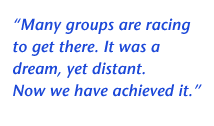Solid-state microcavity UV lasers demonstrated by Sandia, Brown University scientists
They won’t cause sunburns or be found in tanning salons. But the first prototype solid-state microcavity lasers to operate in the ultraviolet (UV) range, with the capability to generate the white light most prized for indoor lighting, have been demonstrated by scientists at Sandia working with colleagues at Brown University in Rhode Island.
Describing his group’s prototype solid-state UV microlaser, Sandia lead scientist Jung Han says, “Many groups are racing to get there. It was a dream, yet distant. Now we have achieved it.”
Startlingly, successful penetration of the lighting market by LED/VCSEL technology by 2025 “should translate into cost savings of $100 billion a year, power generation capacity reductions of 120 gigawatts, and carbon emission reductions of approximately 350 million tons a year (assuming that all the savings come from coal-fired plants),” according to a white paper presented at the Optoelectronics Industry Development Association in Washington in October 1999 by researchers at Sandia and Hewlett-Packard Company of Palo Alto, Calif. “No other major electricity application (motors, heating, refrigeration) represents such a large energy savings potential.”

UV lasers, because they produce shorter wavelengths than other lasers or LEDs, also may be used to write more information on CDs or DVDs, produce higher resolution screen displays, communicate underwater, or activate biological or chemical sensors.
Easily portable UV laser light is also of interest to Sandia researchers because it causes weapons-grade fissionable materials and dangerous E. coli bacterium to fluoresce very efficiently in the visible spectrum, aiding in the detection of attempted thefts and preventing the spread of natural or human-caused epidemics.
“No one before this has achieved the technology to create a compact laser source for UV excitation,” says Jung. “It is important for security work because many molecular bonds of interest do not respond to longer wavelengths of light.” Current detection methods require adding a chemical “tag” that responds to longer-wavelength excitation. Tagging is time-consuming and expensive.
Currently, the invention is in the laboratory stage, powered by bigger, more conventional lasers — a method called optical pumping. The next step is electrical pumping, a more commercially useful way to power such devices. This will require development of connectors that will transmit electricity to the tiny lasers. Jung expects his group to demonstrate this capability in one to two years.
The process of emitting white light by VCSELS is similar to that in standard fluorescent tubes. The inert gases in fluorescent tubes emit UV as electric current flows through them. These rays strike phosphors that coat the tubes’ inside wall, causing them to emit visible light. The tubes, while superior in many ways to incandescent bulbs, burn out in roughly two years, are breakable, contain poisonous mercury vapor, and are not aesthetic.
VCSELS, when coated by phosphors, should produce the same light as a fluorescent tube. But they will last five to ten times longer, be far hardier, and perhaps best of all, will be arranged in designer fashion in any configuration one might wish on ceiling, wall, or furniture.
A paper describing the advance has been accepted for publication in the journal Electronic Letters.
While work on the project had been ongoing for three years, a key advance took place when the element indium was added to the VCSEL materials mix in August 1999. VCSELS are made of nanoscopically thin layers of semiconductor materials that emit photons when electricity is passed through them. While gallium nitride and aluminum nitride both emit in the ultraviolet range, the efficiency with which those materials make use of input power is not high — perhaps about one percent, says Jung. The inspiration of adding indium brought VCSEL efficiency to a tolerable starting point of 20 percent, though it pushed the wavelength emitted longer into the near-ultraviolet range.
“We pay the price for a necessary evil,” says Jung.
(The scientific term near-ultraviolet does not mean “outside the ultraviolet range” but, rather, “close within its borders.”)
In addition to being efficient light-emitting media, some of the layered materials reflect light from both top and bottom surfaces back into the photon-generating area to facilitate the release of still more light, just as do conventional lasers. The successful synthesis of highly reflective bottom mirrors from aluminum-gallium-nitride was another important factor. Sandia, a leader in developing and improving of VCSELS (which are now approaching 50 percent efficiency in infrared and red), traditionally has used titanium oxide as a top dielectric mirror layer. But because that oxide absorbs light below 450 nanometers rather than reflects it, it was not suitable as a mirror for UV. Therefore, hafnium oxide is used in this work.
Many possibilities exist to produce white light from semiconductors and it is not clear which will eventually dominate the market. Blue LEDs, already commercially available, also give off white light through phosphors, but the light so rendered is considered a cold white because it is overbalanced toward the blue spectrum.
Last modified: Oct. 9, 2000